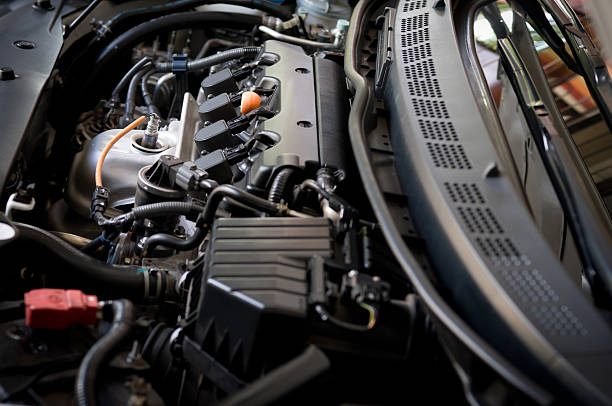The fuel injectors in electronic fuel injection (EFI) engines supply accurate fuel doses to each cylinder. Each cylinder may have one or more fuel injectors, and the intake may even have cold-start fuel injectors. Small electrically controlled valves called fuel injectors can open and close in a matter of milliseconds. Fuel shoots into the cylinder whenever the fuel injector opens.
Dirty fuel injectors may be to blame when examining symptoms like poor engine performance, cylinder misfires, or high emissions. Tiny fuel injector orifices can become blocked over time by debris or fuel impurities. Additionally, chemical buildups can jam gasoline injectors. Inadequate engine performance and poor fuel spray could result from partial blockage.
Can you clean fuel injectors yourself?
Not everyone will want to clean their fuel injectors, but if you want to avoid the garage, it is possible.
Your car could perform poorly, your mileage will suffer, and you might even start to notice your car idling erratically if your fuel injectors become clogged.
You’ll need the following supplies to get started:
- tool set
- compressed air
- kit for cleaning fuel injectors
How do you clean your fuel injectors?
You might want to skip forward to our section on fuel injector cleaning for novices if you have no idea what’s going on under your hood.
You may certainly perform this approach as a newbie because it doesn’t involve any removal. However, it can take longer and you might need your manual’s assistance to find the necessary pieces.
1. Make ready
You should dress adequately before you even begin the cleaning. Although you should only work on cool engines, if an accident does happen, your skin will be protected by a fitting long sleeve top and full-length pants.
The location of where to clean your fuel injectors must then be chosen. You should pick a place with good ventilation because you’ll be utilizing cleaning solvents there; a driveway or open garage work nicely.
It can also go more quickly if you have a place where your tools are set out and easily accessible.
2. Find the fuel injectors.
You might not be aware of their location if you’re cleaning your fuel injectors for the first time (whether for a new car or otherwise). Depending on the make and model of the car, they can be located in various layouts beneath the hood; if in doubt, consult your vehicle’s manual again.
3. Cut the fuel pump’s connection to the fuel injectors.
The fuel injectors should be gently pulled away from the fuel pump by finding it on the engine’s side. Then, to allow the gas to return to the tank while you’re cleaning, connect the gasoline return line to the fuel pump.
4. Disconnect the pressure regulator
You should be able to tell if this step is necessary from your car’s manual. If necessary, simply locate the vacuum line and pressure regulator and gently pull to disconnect.
5. Connect the gasoline port to your cleaning kit.
Find your gasoline port, then adhere to the instructions in your cleaning package to attach the hose and port.
6. Take off the gasoline tank’s lid.
By doing this, an excessive pressure buildup will be avoided.
7. Start the engine of your car.
As you wait for the cleaning agent to finish, start your car (typically 5-10 minutes).
8. Remove your cleaning kit
Reconnect the pressure regulator and the fuel pump before reconnecting your cleaning equipment to the vehicle.
9. Start your vehicle
Your automobile should be in good working order, but keep an ear out for any odd noises. It is preferable to visit a qualified mechanic if you believe you have completed the cleaning properly but your car is still running strangely.
Cleaning a bench fuel injector
The access to the fuel injectors may be simple, but not necessarily.
The only other choices are fuel injector replacement or fuel injector bench cleaning if on-car cleaning is ineffective. Bench cleaning can be a reasonable alternative, depending on the cost and accessibility of new fuel injectors. The fuel injectors will need to be taken out and replaced, much like with new parts, but with an additional cleaning procedure. In a shop, specialized equipment would be used, however fuel injector cleaner can be used at home.
The fuel pressure must be drained, just like with the in-car cleaning. To do this, run the engine while the fuel pump is off or unplugged. The engine will eventually sputter out, at which point you can remove the fuel rail and fuel injectors.
Depending on the vehicle’s year, make, and model, the fuel injectors may need to be removed. While the fuel injectors are easily accessible in some vehicles, they are not in others.
Once the fuel injectors have been taken out, it is possible to clean them one at a time. The exterior of the fuel injectors should be cleaned with a soft-bristle brush and carburetor cleaner or EFI cleaner.
To activate the fuel injector and open it, use a fuel injector jumper. A 9 V battery, some wires, and you might be able to construct a straightforward jumper. Next, squirt cleaner in both directions via the fuel injector.
Reinstall the fuel injectors with fresh O-rings after cleaning, then turn on the engine.
Beginner’s guide to cleaning fuel injectors
Cleaning your car’s engine and fuel injectors is probably just another day’s job for auto aficionados.
The trouble and worry of making a mistake may cause those who are not mechanically inclined to look for the beginner’s alternative.
Fortunately, you can try a rather easy way first before turning to online videos or mechanics.
Most auto repair shops and online retailers sell fuel injector cleaners, which are made to be used quickly and easily:
- Your nearly empty fuel tank should now contain the prescribed amount of cleanser.
- Put the right fuel in the tank.
- When you next need to fill your tank, repeat the process.
Takeaway
It’s recommended to seek professional advice if you’re still having problems with your vehicle, such as decreased fuel economy, poor acceleration, or rough idling. If you’re not comfortable performing the cleaning yourself, a mechanic will be able to do it fast and safely.
Even though fuel injector cleaning is not part of the standard car maintenance, it is an option.
A car maintenance check list and routine servicing will help you identify these problems, preventing a MOT failure, further damage and repair costs, and decreasing the value of your car when you decide to sell it.



